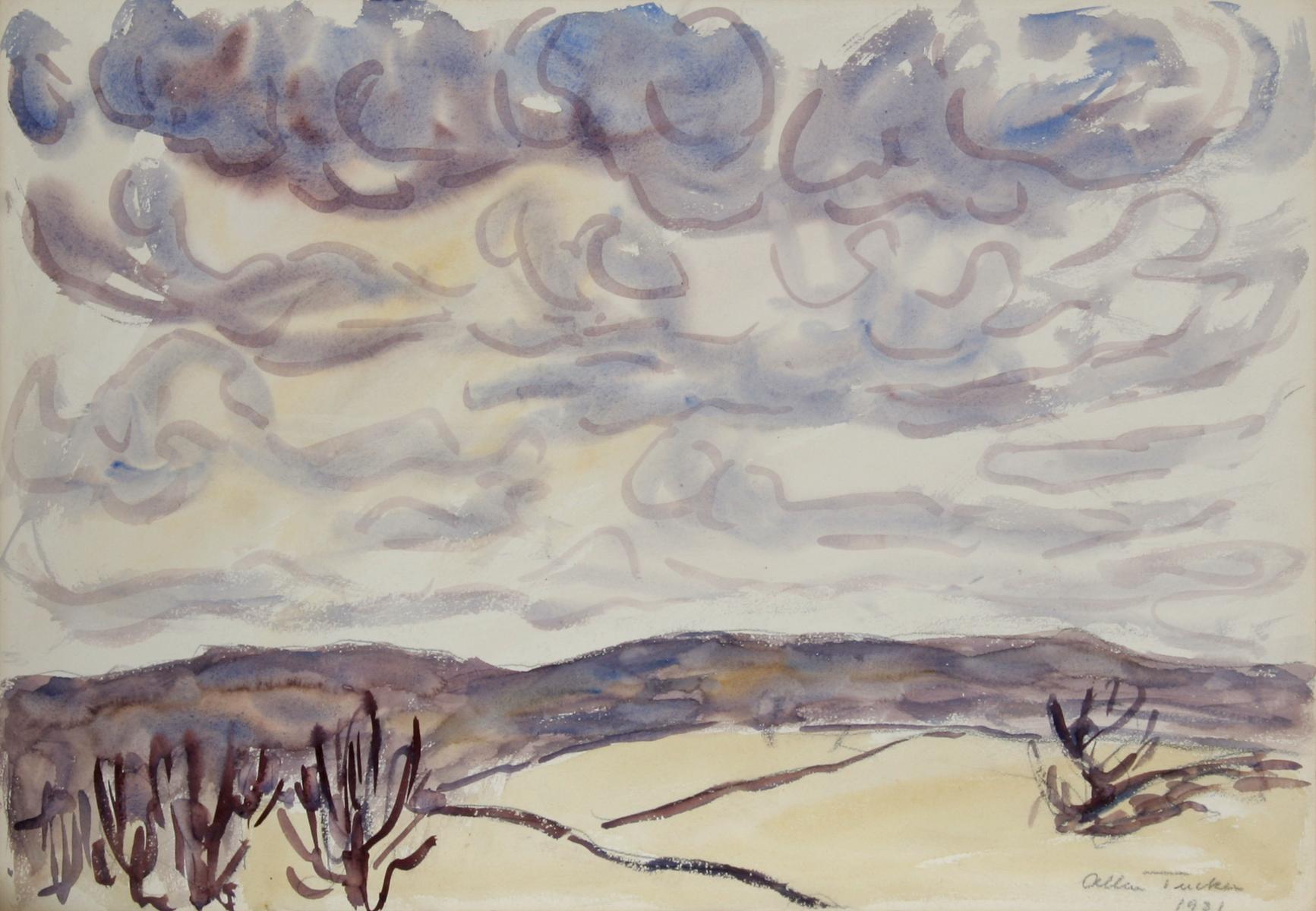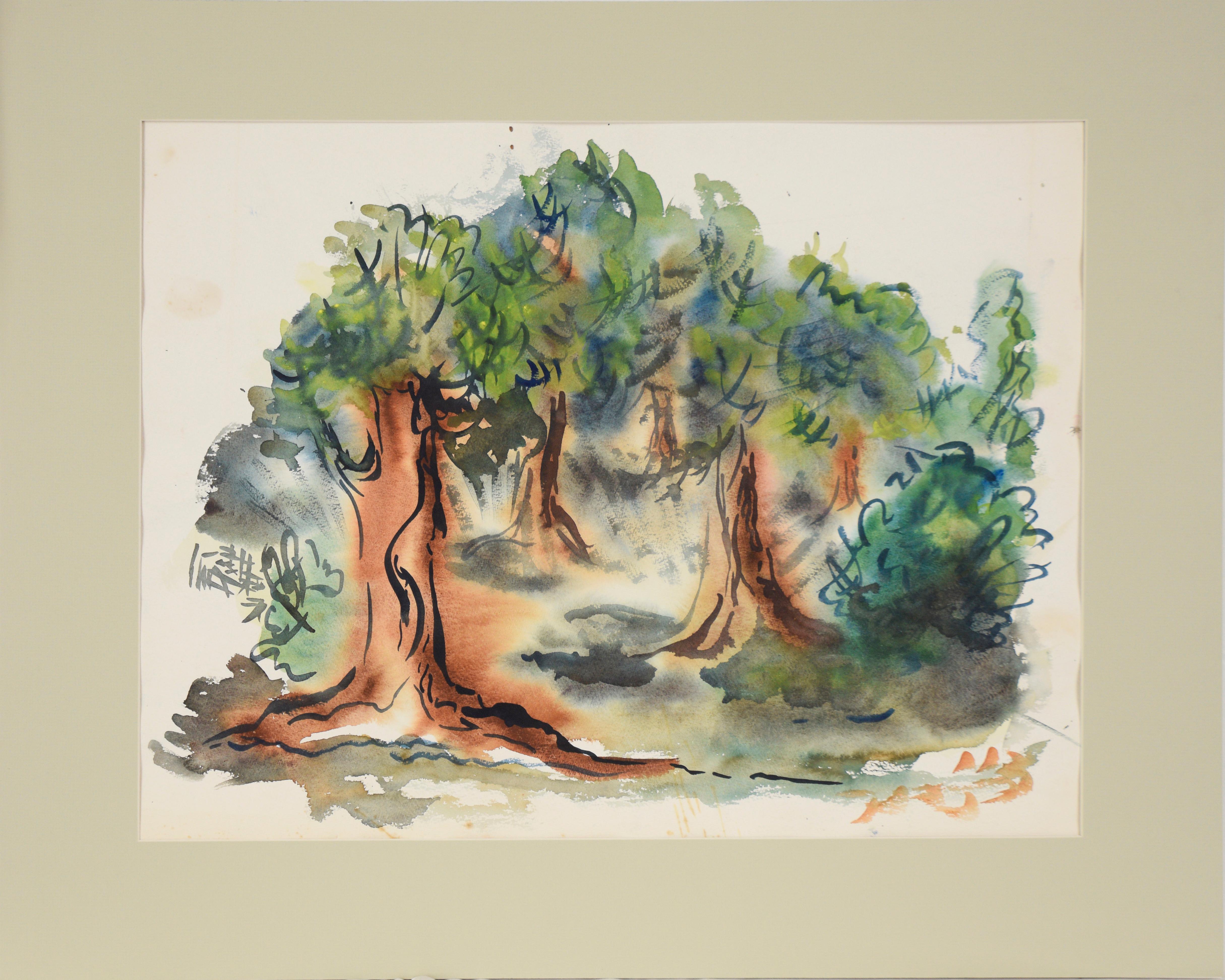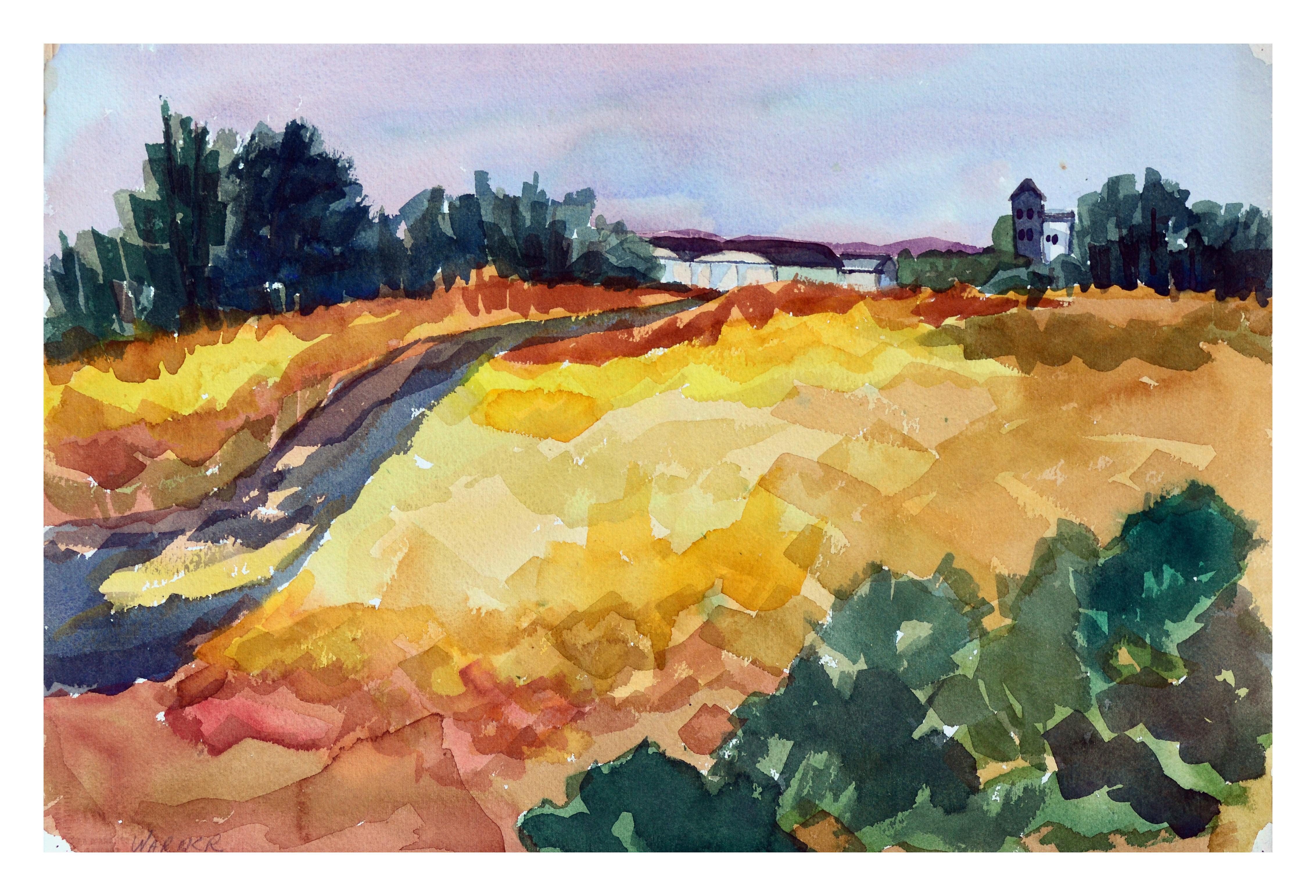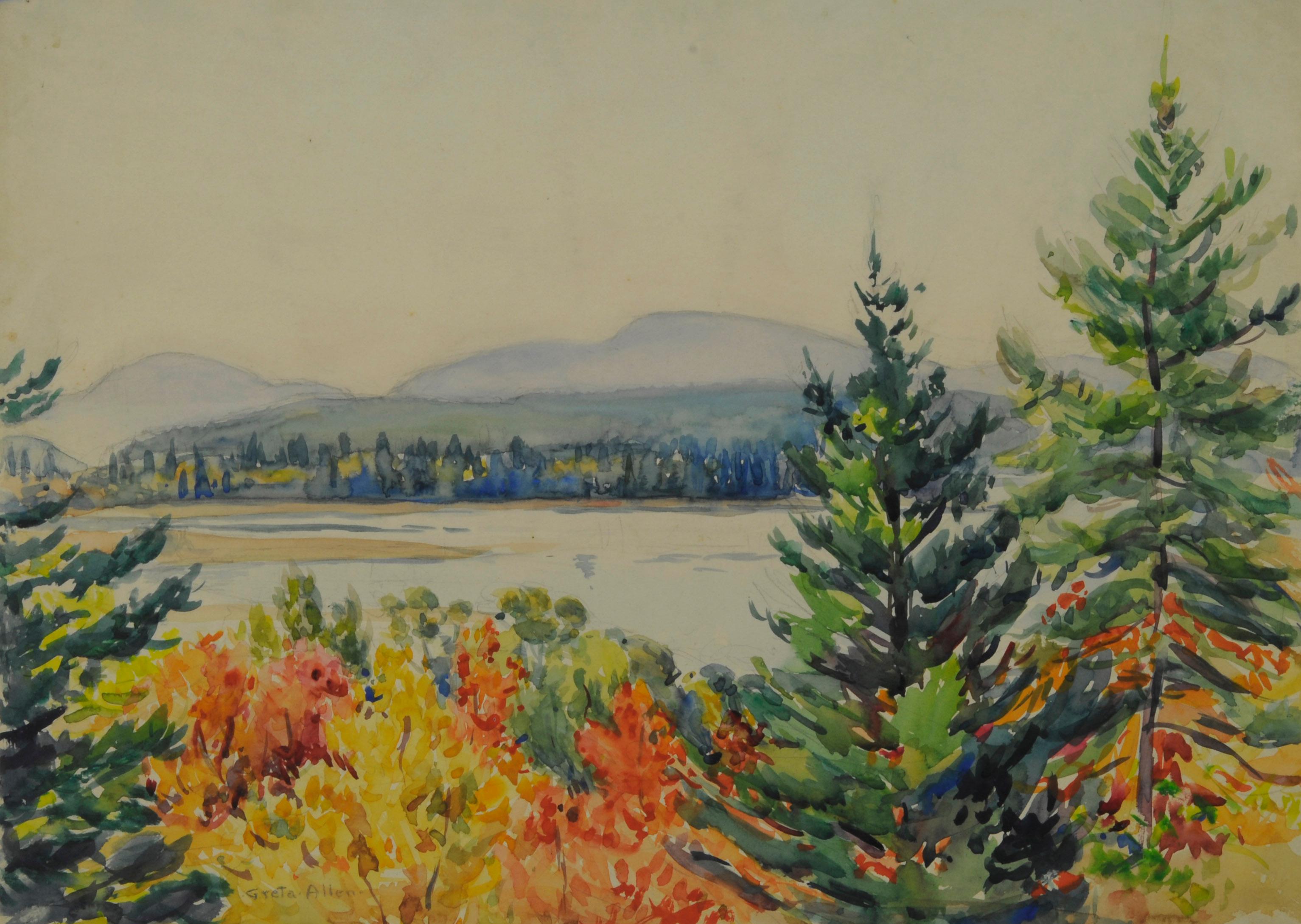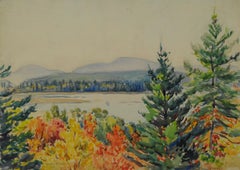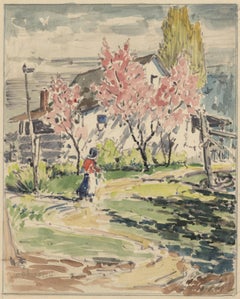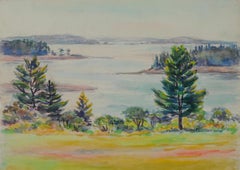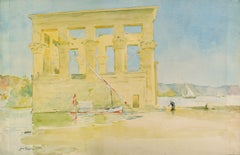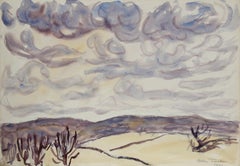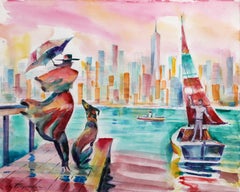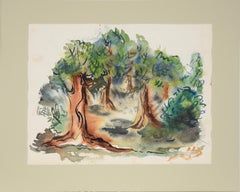Items Similar to Snowy Peaks (Mont Blanc)
Want more images or videos?
Request additional images or videos from the seller
1 of 10
Robert HallowellSnowy Peaks (Mont Blanc)1930
1930
About the Item
Snowy Peaks (Mont Blanc)
Watercolor on paper, c. 1930
Signed "R. Hallowell" lower right (see photo)
The image depicts is of Mont Blanc in France.
Mont Blanc is the highest mountain in the Alps and Western Europe, rising 4,807.81 m above sea level. It is the second-most prominent mountain in Europe, after Mount Elbrus, and it is the eleventh most prominent mountain summit in the world. Wikipedia
Provenance:
From the Estate of the Artist
Marbella Gallery, NYC (label)
Exhibited and Illustrated: Robert Hallowell (1886-1939), Marbella Gallery, New York, Introduction by Ronald G. Pisano, No. 99.
“There is in Mr. Hallowell’s work a grace that amounts to graciousness.”
Leo Stein (1872-1949)
Robert Hallowell (1886-1939) was highly regarded as an artist exhibiting at the finest galleries and museums in American and France in the 1920’s and 1930’s. His other professional life included graduating from Phillips Academy, Andover and Harvard University. While at Harvard he was president of the Harvard Lampoon (1909-1910) and was a founding member of the now famous New Republic Magazine with Walter Lippman and Herbert Croly. Robert worked there as business manager and publisher from 1914 to 1925, when he left to concentrate on his artistic creativity. Hallowell was an official for the Treasury Department during World War One. His final Government posting was as Assistant Director of the Federal Arts Project in 1935-36. How can someone of such cultural involvement have fallen to total obscurity today?
All the works came from Mildred Thaler Cohen (1921-2012), a noted New York collector and gallerist. Along with her first husband, they started collecting American paintings in the 1950’s when they were out of public favor. Upon the death of her husband, she opened the Marbella Gallery on 72nd Street in Manhattan establishing the reputation of being a connoisseur/dealer. The offerings were displayed in her gallery and home salon style.. When and how the Thaler’s acquired the works remain a mystery.
On my first viewing of Hallowell’s artwork, I was taken with his application of paint (oil and especially watercolor) and his color harmonies and delicate shading. The limited scholarship on the artist tells us he was self-taught. All the more impressive. Today, they stand the test of time and should be regarded for their beauty and for the historic acclaim they achieved in the 1920’s and 30’s.
Public Collections:
Phillips Collection, Washington, D.C.
Cleveland Museum of Art
Brooklyn Museum of Art
Baltimore Museum of Art
Harvard University, Adams Hall
McBride Collection
Lewishon Collection
Arthur B. Davies Collection
Metropolitan Museum of Art
Worcester Art Museum
Museum of the City of New York
Fogg Art Museum, Harvard
Museum of Fine Arts, Boston
Denver Museum
Newark Museum
Wilmington Museum
Selected Exhibitions
Bernheim-Jeune, Paris, 1924, 1925
Montrose Gallery, New York, 1924, 1927, 1929, 1932
Memorial Art Gallery, Rochester, NY 1925
Druet Gallery, Paris 1927
Feragil Gallery, New York 1930
Knoedler Gallery, Chicago 1930
McClaus Gallery, Philadelphia 1933
Macbeth Gallery, New York 1934
Paul Reinhardt Gallery, New York 1939
Babcock Gallery, New York 1949
Baltimore Museum of Art
Corcoran Gallery, Washington D.C.
Art Institute of Chicago 1925, 1926, 1927
Pennsylvania Academy of Fine Arts 1927, 1928, 1929
Brooklyn Museum, American Watercolors, Pastels, Collages, 1984
Excerpts from reviews of Hallowell’s exhibitions:
Royal Cortissoz (Art Critic New York Herald Tribune), 1924
“He is a firm and spirited workman, clever in the notation of his light, and very good in his color.”
Leo Stein (1872-1949) noted art critic and brother of Gertrude Stein, wrote in 1925
“There is in Mr. Hallowell’s work a grace that amounts to graciousness.”
New York Times Obituary Notice, Jan. 28, 1939
“…in 1926 a large showing of his watercolors and oils in the Montrose Gallery in New York established his American reputation.”
Elizabeth Luther Cary (1967-1936, the first art critic at the New York Times), 1935
“The paintings of Robert Hallowell speak in fewer words of greater things…Done expertly with a personal emotion…”
Ronald G. Pisano (1948-2000), noted American Art Historian and scholar on the works of William Merritt Chase wrote in the Marbella Gallery catalog of Robert Hallowell’s works:
“His art, like many of his contemporaries, reveals his interest in modernist tendencies introduced to American art in the early 20th century. It is only within recent years that artists such as Hallowell are being appreciated for their full value and whose historical significance is now emerging.”
- Creator:Robert Hallowell (1886-1939, American)
- Creation Year:1930
- Dimensions:Height: 19 in (48.26 cm)Width: 24 in (60.96 cm)
- Medium:
- Movement & Style:
- Period:
- Condition:Fresh Colors, very good condition.
- Gallery Location:Fairlawn, OH
- Reference Number:Seller: FA104101stDibs: LU14010956032
About the Seller
5.0
Recognized Seller
These prestigious sellers are industry leaders and represent the highest echelon for item quality and design.
Platinum Seller
These expertly vetted sellers are 1stDibs' most experienced sellers and are rated highest by our customers.
Established in 1978
1stDibs seller since 2013
724 sales on 1stDibs
Typical response time: <1 hour
Associations
International Fine Print Dealers Association
- ShippingRetrieving quote...Ships From: Fairlawn, OH
- Return PolicyA return for this item may be initiated within 10 days of delivery.
Authenticity Guarantee
In the unlikely event there’s an issue with an item’s authenticity, contact us within 1 year for a full refund. DetailsMoney-Back Guarantee
If your item is not as described, is damaged in transit, or does not arrive, contact us within 7 days for a full refund. Details24-Hour Cancellation
You have a 24-hour grace period in which to reconsider your purchase, with no questions asked.Vetted Professional Sellers
Our world-class sellers must adhere to strict standards for service and quality, maintaining the integrity of our listings.Price-Match Guarantee
If you find that a seller listed the same item for a lower price elsewhere, we’ll match it.Trusted Global Delivery
Our best-in-class carrier network provides specialized shipping options worldwide, including custom delivery.More From This Seller
View Alluntitled (Maine Autumn Landscape across the narrows from Mt. Desert)
By Greta Allen
Located in Fairlawn, OH
untitled (Maine Autumn Landscape across the narrows from Mt. Desert)
Watercolor, 1945-1955
Signed by the artist lower left in pencil (see photo)
Provenance: Estate of the artist
Cond...
Category
1940s American Impressionist Landscape Drawings and Watercolors
Materials
Watercolor
Spring Landscape with house and figure
By Louis Oscar Griffith
Located in Fairlawn, OH
Spring Landscape with house and figure
A preliminary watercolor for a color aquatint, illustrated on line, title unknown
Signed lower left in block letters (see photo)
Watercolor and...
Category
1920s American Impressionist Landscape Drawings and Watercolors
Materials
Watercolor
untitled (Mt. Desert Narrows)
By Greta Allen
Located in Fairlawn, OH
untitled (Mt. Desert Narrows)
Watercolor on paper, c. 1945-1955
Unsigned
Provenance: Estate of the Artist
Condition: Excellent
Image/sheet size: 11 1/4 x 15 3/8 inches
Regarding the ...
Category
1940s American Impressionist Landscape Drawings and Watercolors
Materials
Watercolor
Temple of Isis, View of Philae (verso)
By Henry Bacon
Located in Fairlawn, OH
Temple of Isis
Philae (verso)
Dpouoble sided watercolor, 1902
Signed on front lower left: "Henry Bacon" and dated 1902
Note:
The Temple of Isis is located on the Island of Philae at ...
Category
Early 1900s American Impressionist Landscape Drawings and Watercolors
Materials
Watercolor
Untitled
Located in Fairlawn, OH
Untitled
Watercolor on paper, c,. 1890
Unsigned
Provenance: Estate of the artist
Image/Sheet size: 3 1/4 x 4 1/8 inches
From Wikipedia
"Francis Augustus Lathrop (June 22, 1849 – Oct...
Category
1890s American Impressionist Landscape Drawings and Watercolors
Materials
Watercolor
Standing Lincoln: The Man, Lincoln Park, Illinois
By Louis Oscar Griffith
Located in Fairlawn, OH
Standing Lincoln: The Man, Lincoln Park, Illinois
Watercolor and graphite on paper , c. 1895
Signed in script lower right (see photo)
The scene depicts the Augustus Saint-Gaudens bro...
Category
1890s American Impressionist Landscape Drawings and Watercolors
Materials
Watercolor
You May Also Like
Western Landscape, Watercolor by Allen Tucker 1931
By Allen Tucker
Located in Long Island City, NY
Artist: Allen Tucker, American (1866 - 1939)
Title: Western Landscape
Year: 1931
Medium: Watercolor, signed and dated
Size: 14 in. x 20 in. (35.56 cm x 50.8 cm)
Category
1930s American Impressionist Landscape Drawings and Watercolors
Materials
Watercolor
Windy, Impressionist Watercolor Painting by Erik Freyman
By Erik Freyman
Located in Long Island City, NY
An Art Deco painting of a Fashionable Lady watching her sailor raise his sail by contemporary artist Erik Freyman.
Watercolor on Paper, signed
13 x 16 in. (33.02 x 40.64 cm)
Category
1990s American Impressionist Landscape Drawings and Watercolors
Materials
Watercolor
Mount Monadnock
By Frank Weston Benson
Located in Milford, NH
An exceptional watercolor of Mount Monadnock snow capped in winter in New Hampshire by American artist Frank Weston Benson (1862-1951). Benson was born in Salem, Massachusetts and went on to study in Boston at the Museum School of Fine Arts and later with Julian Lefebvre and Gustave Boulanger at the Academie Julian in Paris. Benson was well known for his impressionist landscapes and seascapes, and etchings of hunting scenes.
Watercolor on paper, signed lower left F.W. Benson with inscription “To Mrs Bush,” titled on Vose Galleries...
Category
Early 20th Century American Impressionist Landscape Drawings and Waterco...
Materials
Paper, Watercolor
Through The Trees - Original Watercolor on Paper
Located in Soquel, CA
Through The Trees - Original Watercolor on Paper
Original watercolor painting depicting a grove of vibrant green trees by Bertram Spencer (American, 1918-1992).
Presented in a lig...
Category
Mid-20th Century American Impressionist Landscape Drawings and Watercolors
Materials
Paper, Watercolor
House on the Hill - Landscape
By Doris Warner
Located in Soquel, CA
Vibrant watercolor painting of a house at the end of a hill by Doris Ann Warner (American, 1925-2010). Doris Ann Warner began as an Abstract Expressionist painter, but was primarily ...
Category
1970s American Impressionist Landscape Drawings and Watercolors
Materials
Paper, Watercolor
$399 Sale Price
20% Off
Horse in the Fields - 1930's Watercolor Figurative Landscape
By John Stellman
Located in Soquel, CA
Horse in the fields, a figurative watercolor landscape by Louis John Stellman (American, 1877-1961), c.1935. Presented in a wooden frame with linen liner. Signed "Stellman" lower right. Image size, 15"H x 19"W.
Stellman moved to CA in 1901. By 1920 he had settled in San Francisco where he worked both as an artist and a writer for the Call-Bulletin newspaper. He later moved to the Monterey Peninsula where he remained until his death. Married to artist Edith K. Stellman (1877-1957). Works held: de Young Legion of Honor.
His books include:
Mate o'dreams and Other Poems
Mother Lode; The Story of California's Gold Rush
Port O' Gold A History-Romance of the San Francisco Argonauts
Said the Observer
Sam Brannan, Builder of San Francisco; A Biography
That Was a Dream Worth Building; the Spirit of San Francisco's Great Fair Portrayed in Pictures and Words
The Vanished Ruin Eta; San Francisco's Classic Artistry of Ruin Depicted in Picture and Song
Stellmann was a protegé of Arnold Genthe...
Category
1930s American Impressionist Landscape Drawings and Watercolors
Materials
Watercolor, Paper
$1,720 Sale Price
20% Off
Recently Viewed
View AllMore Ways To Browse
Robert Grace
G Robert
Elizabeth Roberts
Blanc Vintage
Mountain Peak Painting
Robert Phillips
1930s Collage
Robert Chase
1930s 1920s Impressionist
Paintings By Robert Phillip
1886 The City Of New York
French Alps Landscape
M Cohen
New Acquired French Impressionist Paintings
B Cohen
Walter Paris Watercolor
Mont Blanc Art
Snowy Mountain Painting
